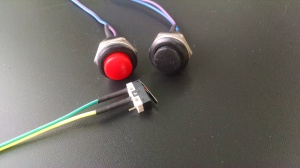
Why Arduino?
The greatest advantage to using the Arduino family of microcontrollers for DIY electronics projects, is that they are ubiquitous. Since they are so available, they are inexpensive and you can find open-source software to get started.
If you’ve ever had the opportunity to work with an Arduino Uno microcontroller board, then you’ve probably executed the flashing LED example. Going further, you might attach a button, or switch, to trigger the LED or to turn it off making the project interactive. There are many sensors that could be connected to the Arduino Uno and setup to trigger events, such as the LED flashing, using threshold values that we would need to experiment with in order to figure out what settings work best for creating the effect we want.
While the examples that come with the Arduino software and the examples included with libraries are an excellent start to a project; the Arduino family of microcontrollers is often grossly underutilized in many projects. Sure microcontrollers are limited in how many instructions they can run; hitting the program size limit doesn’t take very long when you want to control more than a few blinking LEDs. Even with creative variable handling and custom libraries, eventually, there is a need for another microcontroller or to move to a larger one, even a Raspberry Pi.
In my Alien Invasion Slot Machine project, I tried to push the Arduino closer to its limits.
Time Management and state and trigger flags
At its most basic, a microcontroller loops through a set of instructions handling each action with the focus of The Red Eye of Sauron from Lord of the Rings. There are a few interrupts that can be configured should an event be so important to receive the full attention of the microcontroller. Using some form of time management creates a state machine. If x amount of time has passed since x event, then do something and so on…
“The behavior of state machines can be observed in many devices in modern society that perform a predetermined sequence of actions depending on a sequence of events with which they are presented. Simple examples are vending machines, which dispense products when the proper combination of coins is deposited, elevators, whose sequence of stops is determined by the floors requested by riders, traffic lights, which change sequence when cars are waiting, and combination locks, which require the input of combination numbers in the proper order.” https://en.wikipedia.org/wiki/Finite-state_machine
There are rare instances where: RTOS, AI, neural networks exist on microcontrollers, but that’s best left to software-oriented systems such as a Raspberry Pi.
After trying many different timer and time management libraries I felt they were either too much or not enough of what I was wanting in my timers. A set of timers that are easy to set, keep track of their own state, and each have their own trigger flags.
Button assumptions

Interacting with an electronics device such as a microcontroller or computer system is relatively easy and typically provided as an example for developers looking to use the device in their project. Press a button and an LED illuminates. A button or switch may seem like a simple sensor input, but it’s not.
The device’s system resources are consumed waiting and watching for a button press. When we use a button in a project we typically think of it being activated when pressed. Then what? What should happen if the user holds the button in the active position? Will the button be counted as pressed once, or is the program going to count each second, or x amount of time, as another button press? Does the program need to know that the button has been released?
Hardware and wiring

Rather than using the Arduino Uno and a protoboard or breadboard for this project, I’m using the Arduino Nano on an expansion board. Keep it simple using common wiring colors, keep it modular so connections can be made with ease, keep your project sustainable; a part can be replaced rather than the entire system. The DuPont wire connectors that come with prototyping starter kits makes it easy to create your own custom wiring connections. The wires are easy to solder when a more permanent connection is needed. I make custom wiring harnesses for neater, cleaner, and more easily connectable modules.
Raspberry Pi
The latest version of the Raspberry Pi v3 uses a Linux OS and is a computer that can do so much more than an Arduino Uno, why not just use it for everything? While it is possible to do many of the same tasks as you would do with the Arduino Uno or variant, it’s not always best. The Arduino Uno and variant microcontrollers are best for doing the same actions, over and over again, such as reading a sensor and doing something with the value.
As I mentioned previously, you can do a lot with a Raspberry Pi, and depending on how much you are doing, it won’t take too long before you discover it has limits. When the Pi overheats, it will either freeze or shutdown, hopefully, the processor has a heatsink.
More Info:
- Why DIY when you could buy?
- Making a Lightshow with Arduino
- Making Sound Effects with Arduino
- Working with Multiple Sensors and Arduino
- Using a Raspberry Pi and USB Camera
- Using a Raspberry Pi for your own Inventory Management System
Please share with friends and follow to receive a notification when I publish a new article.


Additional Reasons to Choose Arduino microcontrollers over Raspberry Pi
* simplicity — no need to fight with several layers between you and the hardware, various services
* power consumption
* ability to time signals
* space required for the circuit (e.g. in IoT scenarios)
* no failures / hangs due to SD cards etc.
LikeLike